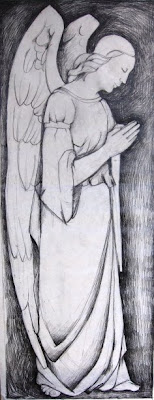prossimo Progetto 
Leo Paglione. He was born in Capracotta (Isernia) June 12, 1917. Having already artistic talents, the master Ottorino Conti, invites him to move to Camp where you enter the shop of Amedeo Trivisonno. From 1945 begins busy as a decorator of churches and chapels in Molise, Avellino and Rome. In 1948 he was present at the national exhibition in Pescara, in 1958 and 1959 in Termoli, then at the National Exhibition of Art Camp, where he was awarded a silver medal. Important frescoes are Capracotta, Carovilli, Carpinone, Isernia, Montefalcone, Pescopennataro, Sepino, Trivento and Vincent. Valuable Way of the Cross made in 1994 and kept in the church of San Giovannello in Campobasso. He died May 21, 2004 in Campobasso hit by a motorcycle on a Giambattista Vico. He writes of the painter Gino Marotta: "The first and oldest memory I have of Leo is linked to the extreme discretion of his behavior at the edge of quiet silence. His calm manner and the nature of confidentiality prevented him from discussing or participate in simple conversations, it seemed a kind of few words. He spoke little because his education did not allow him to say things that expose him to all sorts of leadership. Among the many painters, more or less tied to Trivisonno, Leo was the only real student in the full sense of the word. It can be said that his training and apprenticeship painting techniques before and after the decoration are entirely dependent Amedeo Trivisonno, a relationship that soon turned into a sort of partnership in which very often have exchanged the roles for which a Sometimes it is difficult to determine whether a work is certainly autograph of the master or the result is a virtuoso to make a duet. "Analysis of the" school campobassana "The School Art Camp" was born from a continuous and daily contact with artists who, though not considered to carry out joint research, however, trust each other the results achieved. Marcello Scarano had been in Rome since autumn 1924 and remained there almost continuously until the end of 1925 and part of 1926. Amedeo Trivisonno was also in Rome in 1922 and 1923, before continuing his studies in Florence in the coming years. One day they will say that the new painting, one that is usually identified with the Roman School of Via Cavour (Scipio, Mafai, Mazzacurati and Raphael) or the "new Neapolitan School" (which was owned Crisconio), in effect had been anticipated by the School of Campobasso. In the book "Marcello Scarano and his painting" was shown the route that the artist had done before Molise all the other artists of the schools mentioned above. It must be said, at this moment, what seemed isolation of the artist Scarano, highlighted by the most authoritative critics, in fact it was intended: as if to signify that the painter wanted to come alone, in spite of its traditional standards of study that require a presence, even indirect, of a master. Scarano's painting has nothing to do with the resolution adopted by the frescoes Amedeo Trivisonno and you can (at least as far as the first and most important) still be seen today in the cathedral of Campobasso. But if you look at the painting profane Trivisonno, if you look carefully at works of portraiture such as "Dante Chiodini" or "Dr. D'Agostino" or "Silvia Scarano" in the late 20's (All between 1926 and 1927), there is some setting that is also the way the coloristic Scarano. The signal strength of traditional ties that bound the local culture to that of Naples, continues in those years by famous artists such as Arnaldo de Lisio Molise (Castelbottaccio 1869-Naples 1949) and Francesco Paolo Diodati (Campobasso 1864-Naples 1940); It is part of Scarano and reprinted by Trivisonno. In fact just part of the frescoes is easy to make comparisons with works that are located in Campobasso, in the Savoy cinema and theater and the headquarters of the Bank of Italy and the works of de Lisio those cited in the cathedral of Trivisonno. The evidence of the cultural tradition maintained Neapolitan dal primo è spezzata ed ignorata dal secondo. A voler essere precisi, della Scuola vera e propria campobassana potrebbero essere chiamati a far parte, per un periodo relativamente breve e non ancora completamente identificato, anche Romeo Musa (Calice di Bedonia 1892/Milano 1960), le cui opere sono visibili all’Istituto “Mario Pagano” di Campobasso ed una sua grande tela “La sagra del Matese” dovrebbe sempre essere nella biblioteca del Provveditorato agli studi del Molise nel capoluogo; e Giovanni Ruggiero (Isernia 1892/Roma 1971), cui si deve anche la copertina del catalogo della IV Sindacale d’Abruzzo e Molise tenutasi a Campobasso nell’agosto 1937. Poi arriva Giovanni Leo Paglione, l’unico vero allievo di Trivisonno, beniamino nascosto di Marcello Scarano, al quale si avvicinerà molto dopo la partenza del suo Maestro Amedeo per l’Egitto. Ed il cerchio si chiude.







